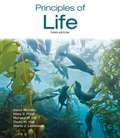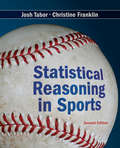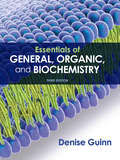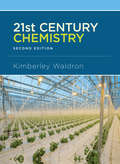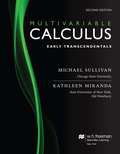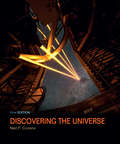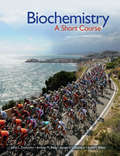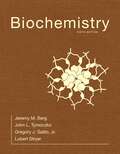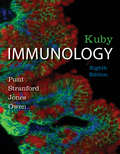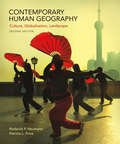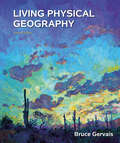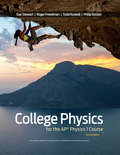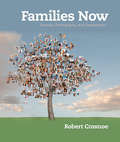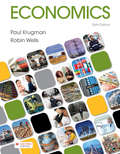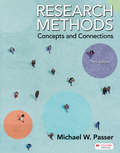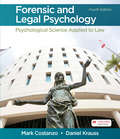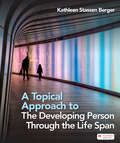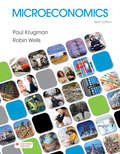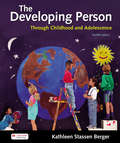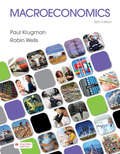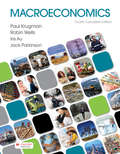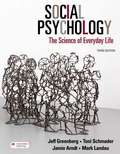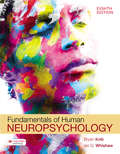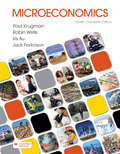Special Collections
Benetech’s Global Certified Accessible Titles
Description: Benetech’s GCA program is the first independent third-party EPUB certification to verify ebook accessibility. By creating content that is born accessible, publishers can meet the needs of all readers. Learn more: https://bornaccessible.benetech.org/
- Table View
- List View
Principles of Life
by David Sadava and David Hillis and Richard Hill and Mary PriceFor instructors concerned that the practical skills of biology are lost when the student moves on to the next course or takes their first step into the “real world,” Principles of Life 3e lays the foundation for later courses and for students’ careers. Expanding on its pioneering concept-driven approach, experimental data-driven exercises, and active learning focus, PoL 3e introduces features designed to involve students in mastering concepts and becoming skillful at solving biological problems. Research shows that when students engage with a course, it leads to better outcomes. Principles of Life 3e is a holistic solution that has been designed from the ground up to actively engage students in mastering concepts and becoming skilled at solving biological problems. Within LaunchPad, our digital teaching and learning solution, we provide thoughtfully curated assignments and activities to support pre-lecture preparation, classroom activities, and post-lecture assessment. With its focus on key competencies foundational to biology education and careers, self-guided adaptive learning, and unparalleled instructor resources for active classrooms, Principles of Life is the resource students need to succeed.
Statistical Reasoning in Sports
by Christine Franklin and Josh TaborStatistical Reasoning in Sports by Christine Franklin and Josh Tabor
Essentials of General, Organic, and Biochemistry
by Denise GuinnThe essential chemistry for health careers and everyday life. Guinn’s Essentials of General, Organic and Biochemistry 3e uses health and medicine as the framework for learning the fundamentals of chemistry. Focusing on core concepts and necessary math skills, the easily digestible content and medical applications help reduce student anxiety and make chemistry meaningful for students preparing for future careers in nursing and other allied health professions. Paired with SaplingPlus and an embedded eBook, students will be able to focus their study with adaptive quizzing and understand the relevance of chemistry through videos, animations and case studies.
Environmental Science for the AP Course
by Andrew Friedland and Rick RelyeaEnvironmental Science for the AP® Course was built from the ground up specifically to suit the needs of AP® environmental science teachers and students. Friedland/Relyea integrates AP® content and exam prep into a comprehensive college-level textbook, providing students and teachers with the resources they need to be successful in AP® Environmental Science. Features throughout the textbook include AP® Exam Tips, math tutorials and review, review questions, and complete AP® Practice Exams. Strong media offerings include online homework to provide just-in-time feedback, as well as adaptive quizzing. Environmental Science for the AP® course provides students with the support they need to be successful on the AP® Environmental Science exam and in the college classroom.
Multivariable Calculus
by Michael Sullivan and Kathleen MirandaMichael Sullivan and Kathleen Miranda have written a contemporary calculus textbook that instructors will respect and students can use. Consistent in its use of language and notation, Sullivan/Miranda’s Calculus offers clear and precise mathematics at an appropriate level of rigor. The authors help students learn calculus conceptually, while also emphasizing computational and problem-solving skills. The book contains a wide array of problems including engaging challenge problems and applied exercises that model the physical sciences, life sciences, economics, and other disciplines. Algebra-weak students will benefit from marginal annotations that help strengthen algebraic understanding, the many references to review material, and extensive practice exercises. Strong media offerings include interactive figures and online homework. Sullivan/Miranda’s Calculus has been built with today’s instructors and students in mind.
Discovering the Universe
by Neil CominsDiscovering the Universe: From the Stars to the Planets engages students with an inquiry-based exploration of the universe and the scientific process.
Developed with a “big picture” approach, the text first explains how the stars, the galaxies, and the entire universe formed, and then discusses planets and other components of our solar system.
Students follow this natural conceptual progression within a proven learning method designed to address misconceptions and build a deep understanding of science and the world around us.
Biochemistry
by Lubert Stryer and John Tymoczko and Jeremy Berg and Gergory GattoDerived from the classic text originated by Lubert Stryer and continued by John Tymoczko and Jeremy Berg, Biochemistry: A Short Course focuses on the major topics taught in a one-semester biochemistry course. With its brief chapters and relevant examples, this thoroughly updated new edition helps students see the connections between the biochemistry they are studying and their own lives. The focus of the 4th edition has been around: * Integrated Text and Media with the NEW SaplingPlus Paired for the first time with SaplingPlus, the most innovative digital solution for biochemistry students. Media-rich resources have been developed to support students' ability to visualize and understand individual and complex biochemistry concepts. Built-in assessments and interactive tools help students keep on track with reading and become proficient problem solvers with the help and guidance of hints and targeted feedback--ensuring every problem counts as a true learning experience. * Tools and Resources for Active Learning A number of new features are designed to help instructors create a more active environment in the classroom. Tools and resources are provided within the text, SaplingPlus and instructor resources. * Extensive Problem-Solving Tools A variety of end of chapter problems promote understanding of single concept and multi-concept problems. Built-in assessments help students keep on track with reading and become proficient problem solvers with the help and guidance of hints and targeted feedback--ensuring every problem counts as a true learning experience. Unique case studies and new Think/Pair/Share Problems help provide application and relevance, as well as a vehicle for active learning.
Biochemistry
by Jr. and John L. Tymoczko and Jeremy M. Berg and Lubert Stryer and Gregory J. GattoBiochemistry
Kuby Immunology
by Patricia Jones and Jenni Punt and Sharon Stranford and Judith OwenJanis Kuby’s groundbreaking introduction to immunology was the first textbook for the course actually written to be a textbook. Like no other text, it combined an experimental emphasis with extensive pedagogical features to help students grasp basic concepts.
Contemporary Human Geography
by Roderick P. Neumann and Patricia L. PriceWith each chapter organized by five themes (region, mobility, globalization, nature-culture, cultural landscape), Contemporary Human Geography introduces students to geography concepts through fascinating topics such as the distribution of college sports, the relationship of beauty pageants and cultural identity, texting and language modification, and more, continually reinforcing geographers’ contributions to our understanding of how we live in a globalized, modern world. The authors frame this coverage using specific learning objectives to help students focus on essential concepts and prepare for class discussions, assignments, and exams.
Contemporary Human Geography comes with two of Macmillan’s online course spaces, allowing instructors to choose how much media and assessment they’d like to make available for their students, and at what price point. SaplingPlus offers innovative media content, curated assessments, and brand new mapping activities powered by Esri. Achieve Read & Practice combines the accessibility of a VitalSource e-book with our self-paced, formative quizzing engine, LearningCurve.
Living Physical Geography
by Bruce GervaisThe second edition of Bruce Gervais’ Living Physical Geography offers a fresh approach to the study of physical geography, combining print and digital media to create a scientifically substantive work that is written for students. Living Physical Geography focuses on human-physical geography interactions, using pedagogical features in the textbook and online in SaplingPlus to create a modern synthesis of the science of physical geography. In this, the most student-friendly book in the market, the authors Bruce Gervais has curated and designed all of the learning assets within the text and online in SaplingPlus. Each of the four major parts in Living Physical Geography focuses on energy flows within Earth’s physical systems. Additionally, landscape analysis underpins the body of the text. Step-by-step examples are used to illustrate how landforms and systems develop, evolve, and change through time.
College Physics for the AP Physics 1 Course
by Roger Freedman and Gay Stewart and Todd Ruskell and Philip KestenCollege Physics for the AP® Physics 1 Course is the first textbook to integrate AP® skill-building and exam prep into a comprehensive college-level textbook, providing students and teachers with the resources they need to be successful in AP® Physics 1. Throughout the textbook you’ll find AP Exam Tips, AP® practice problems, and complete AP® Practice Exams, with each section of the textbook offering a unique skill-building approach. Strong media offerings include online homework with built-in tutorials to provide just-in-time feedback. College Physics provides students with the support they need to be successful on the AP® exam and in the college classroom.
Families Now
by Robert CrosnoeFamilies Now: Diversity, Demography, and Development offers a modern, integrative approach to understanding families, reflecting the dynamic changes occurring in family life and institutions in the United States, while also accounting for the social and economic history that has compelled these changes. With decades of experience researching the way families live, no one is better positioned to write about 21st century family life than Robert Crosnoe. Crosnoe�s Families Now examines families today by exploring three essential themes: 1) The diversity of family life, 2) How integral family is to healthy people and a healthy society, and 3) How family is constantly evolving. Backed by cutting-edge data and a variety of pedagogical tools, this thematic approach is an effective new way to help students get a deeper understanding of families�and as importantly, a deeper understanding of themselves.
Economics
by Paul Krugman and Robin WellsWith its signature storytelling style and coverage of current issues and events, Nobel laureate and New York Times columnist Paul Krugman and co-author, Robin Wells�s best-seller is the most effective textbook available for explaining how economic concepts play out in our world.This new edition offers incisive new insight into market power and externalities in microeconomics, updated analysis of long-run growth, and extensive coverage of the economic impacts and policy responses to the coronavirus pandemic in macroeconomics.
Research Methods
by Michael PasserWith over two decades of classroom experience, Michael Passer knows how to guide students through the ins and outs of research methods. In this remarkable text, Passer�s experience leads to chapters filled with clear explanations, resonant examples, and contemporary research from across the breadth of modern psychology, all while anticipating common questions and misunderstandings.
Forensic and Legal Psychology
by Mark Costanzo and Daniel KraussMark Costanzo and Daniel Krauss�s text show students how psychological science can be used to reduce crime, improve legal decision making, and promote justice. Fully integrated discussions of real cases and trials, along with other examples of the legal system in action, show how research and theory can deepen our understanding of suspects, criminals, police, victims, lawyers, witnesses, judges, and jurors.
A Topical Approach to the Developing Person Through the Life Span
by Kathleen Stassen BergerThis is not a reorganized iteration of another Berger textbook, but rather a fully reconceived first edition exploring human development topic by topic. But as always with Berger, it is exceptionally accessible and compelling, distinguished by an engaging narrative voice, wide-ranging cultural perspective, and an emphasis on relating universal themes to students' own lives.
Microeconomics
by Paul Krugman and Robin WellsWith its signature storytelling style and coverage of current issues and events, Nobel laureate and New York Times columnist Paul Krugman and co-author, Robin Wells�s best-seller is the most effective textbook available for explaining how economic concepts play out in our world.This new edition offers incisive new insight into market power and externalities in microeconomics, updated analysis of long-run growth, and extensive coverage of the economic impacts and policy responses to the coronavirus pandemic in macroeconomics
Developing Person Through Childhood and Adolescence
by Kathleen Stassen BergerKeep this book to understand the development of children and adolescenceInvestigate childhood and adolescent development with The Developing Person Through Childhood and Adolescence. Compelling stories connect classic and current research and the lives of real people from a variety of cultures to the field�s core theories and concepts, giving readers a more complete picture of this area of study.
Macroeconomics
by Paul Krugman and Robin WellsWith its signature storytelling style and coverage of current issues and events, Nobel laureate and New York Times columnist Paul Krugman and co-author, Robin Wells�s best-seller is the most effective textbook available for explaining how economic concepts play out in our world.This new edition offers incisive new insight into market power and externalities in microeconomics, updated analysis of long-run growth, and extensive coverage of the economic impacts and policy responses to the coronavirus pandemic in macroeconomics.
Macroeconomics
by Paul Krugman and Robin Wells and Iris Au and Jack ParkinsonWhen it comes to explaining fundamental economic principles by drawing on current economic issues and events, there is no one more effective than Nobel laureate and New York Times columnist Paul Krugman and co-authors, Robin Wells, Iris Au, and Jack Parkinson. In this best-selling introductory textbook, the authors’ signature storytelling style and uncanny eye for revealing examples help readers understand how economic concepts play out in our world. Canadian co-authors Jack Parkinson and Iris Au have enhanced the text with current Canadian examples.
Social Psychology
by Jeff Greenberg and Toni Schmader and Jamie Arndt and Mark LandauWith Macmillan’s superior content delivered by LaunchPad, Social Psychology offers a fresh approach to the study of social psychology, that no other available text can match. The authors draw on over 50 years of combined teaching and research to guide students through the rich diversity of the science of social psychology, weaving together explanations of theory, research methods, empirical findings, and applications to show how social psychologists work to understand and solve real-world problems. The new edition’s LaunchPad brings together all student and instructor resources, including an interactive e-book, LearningCurve adaptive quizzing, Video Activities, The Science of Everyday Life Experiments and Activities, and more.
Fundamentals of Human Neuropsychology
by Bryan Kolb and Ian Q. WhishawFundamentals of Human Neuropsychology continues to keep pace with its dynamic field, just as it has done throughout its nearly four decades of publication. As they have done since the first edition, the authors draw on recent research and their own clinical and lab experience to guide their development of the content, and on their experience in the classroom to help hone the presentation in a way that is both accessible and engaging to students. Coverage includes recent developments in network analysis, neural imaging, and genetic research�particularly in terms of the impact on our understanding and assessment of brain injury and disorders.
Microeconomics: Canadian Edition
by Paul Krugman and Robin Wells and Iris Au and Jack ParkinsonWhen it comes to explaining fundamental economic principles by drawing on current economic issues and events, there is no one more effective than Nobel laureate and New York Times columnist Paul Krugman and co-authors, Robin Wells, Iris Au, and Jack Parkinson. In this best-selling introductory textbook, the authors� signature storytelling style and uncanny eye for revealing examples help readers understand how economic concepts play out in our world. Canadian co-authors Jack Parkinson and Iris Au have enhanced the text with current Canadian examples.
